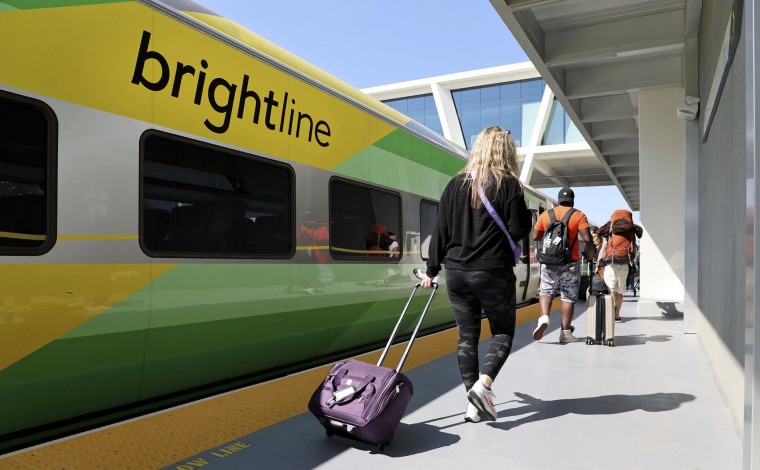The Department of Transportation announced more than $6 billion in grant funding for high-speed rail projects this week. The money comes amid ongoing support for a technology that has also encountered concerns about its costs.
Brightline West, an affiliate of Florida’s Brightline intercity rail service, was awarded $3 billion in federal funds for its proposed line between Las Vegas and Los Angeles, which would zoom passengers between the cities in two hours.
The California High-Speed-Rail Authority was awarded $3.1 billion to continue work on its system, which will ultimately connect Los Angeles and San Francisco in less than three hours.
Definitions of high-speed rail vary, but it typically refers to passenger trains that travel at least 125 mph and can reach more than 220 mph.
The technology has been around since the 1960s, when Japan inaugurated its Shinkansen line between Tokyo and Osaka. Since then, high-speed rail projects have sprung up around the world, with China having built a network of almost 25,000 miles.
The U.S. has been slower to adopt the technology. It doesn’t currently operate any high-speed rail lines, although Amtrak’s Acela in the Northeast sometimes reaches speeds of 150 mph.
That’s despite a growing choir of experts and activists who support what they see as a technology with urgent benefits, as well as public support for high-speed rail.

A 2022 survey from the University of California Berkeley and The Los Angeles Times found 56% of registered voters supported continuing the state’s project versus 35% against.
“I think once California’s system opens, people will say, ‘Wow, this is actually really helpful and useful,’” said transportation engineer and public-transit activist Hayden Clarkin.
“So we’re waiting with bated breath for these systems to open up.”
The grant money announced this week will primarily fund construction of that system in the Central Valley, according to a press release from the California High-Speed Rail Authority.
That portion of the project will connect Merced, Fresno and Bakersfield sometime between 2030-33. Once that’s complete, the project will extend into the Bay Area and eventually Los Angeles.
So far, the California High-Speed Rail Authority has laid 119 miles of track in the Central Valley and created more than 12,000 jobs at a cost of $11.2 billion. The total expense is estimated to land between $88 billion and $128 billion, which has drawn concerns about whether the project is worth the cost.
Brian P. Kelly, CEO of the California High-Speed Rail Authority, dismissed concerns about ballooning costs.
“For me the narrative is a little tired,” he told NBC.
Kelly said the original $9 billion authorization approved in 2008 was never meant to cover the total expense, and added that things cost more now than in 2008.
“A lot of time has gone by,” Kelly said. “A loaf of bread or gallon of milk doesn’t cost in 2023 what it cost in 2008.”
He said the tab remains in line with costs internationally to build high-speed rail, and that if the state were to expand highways to match the carrying capacity of this rail system, it would cost about double.
“From a mobility, environmental and economic perspective,” he said, “this project is a no-brainer.”
Other advocates agree.
Architect Adam Paul Susaneck recently designed a hypothetical high-speed rail route that made the rounds online, connecting Boston, Philadelphia, New York City, Washington, D.C., Toronto and Montreal.
The design, he admits, is purposely provocative and maximalist. But he said he hopes it will spark progress on more feasible high-speed rail projects.
“What inspired me was the desire that a lot of people have, which is to see a functioning high-speed rail system,” Susaneck told NBC News.
He thinks a competent system, like the one being built in California, would revolutionize commercial and economic activity.
Susaneck — whose personal project @Segregation_by_Design studies the extent to which the United States used transportation and housing policy to segregate cities by race and class — also thinks high-speed rail could help heal cities whose downtowns were obliterated by “urban renewal” undertakings in the mid-20th century.
He says it would help curb climate change, too, noting that one of the best ways to reduce emissions is to get people out of cars and into trains.
Clarkin, who has amassed more than 112,000 followers on the social media platform X with posts about public transit, put it more succinctly.
“I’m just trying to train-pill people,” he said.
from U.S. - Latest - Google News https://ift.tt/5TkCKNq
via IFTTT
Tidak ada komentar:
Posting Komentar